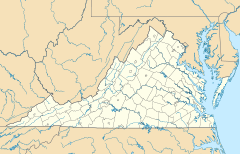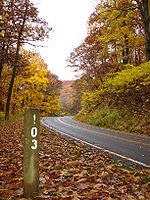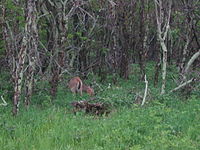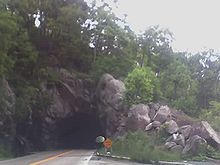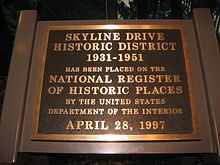- Skyline Drive
-
- This article refers to the road in Shenandoah National Park in Virginia. For the park itself, see Shenandoah National Park. For other roads named Skyline Drive, see Skyline Drive (disambiguation).
Skyline Drive Historic District Skyline Drive near Big Meadow
Skyline Drive near Big MeadowNearest city: Luray, Virginia Coordinates: 38°32′54″N 78°27′38″W / 38.54833°N 78.46056°WCoordinates: 38°32′54″N 78°27′38″W / 38.54833°N 78.46056°W Built: 1931 Architect: multiple Architectural style: Other Governing body: National Park Service MPS: Historic Park Landscapes in National and State Parks MPS NRHP Reference#: 97000375[1] Added to NRHP: April 28, 1997 Skyline Drive is a 105-mile (169-km) road that runs the entire length of the National Park Service's Shenandoah National Park in the Blue Ridge Mountains of Virginia, generally along the ridge of the mountains. The scenic drive is particularly popular in the fall when the leaves are changing colors. Annually, over two million people visit the Skyline Drive, which has been designated a National Scenic Byway.
Contents
Entry
Major entry points to Skyline Drive are as follows:
- Front Royal, Virginia (U.S. Highway 340), the northern terminus
- Thornton Gap (U.S. Highway 211)
- Swift Run Gap (U.S. Highway 33)
- Rockfish Gap (Interstate 64, U.S. Highway 250), the southern terminus.
As of October 2011, the entry fee for all vehicles is $15 for a single car, and $10 for motorcycles. The fee varies based on the season. Passes, which are valid for unlimited entries within a seven-day period, are issued. Payment may be made with cash, credit, or debit cards. A year-long pass can be purchased for $30 (A Season Pass will admit 2 motorcycles).
Mileposts
On the west side (right when traveling from north to south) of the drive, mileposts are present. They are numbered from 0 to 105 (north to south). These are the reference points to directions in the drive.[2]
Driving precautions
The speed limit is 35 miles per hour (60 km/h), due to curves, wildlife and tourists. One might see stopped vehicles in the road either enjoying the wildlife or just turning to stop at an overlook. Bicycles, vehicles and pedestrians share the road. There are also deer, bear, and other wildlife crossing the road which may appear without warning. These all require extra precaution. The speed limit within the park is strictly enforced by park police.
Experience
As the name suggests, the road takes a winding path along the mountaintops of the Blue Ridge Mountains east of the Shenandoah River. There are nearly seventy-five overlooks throughout the drive, giving some of the most spectacular views of the surrounding valleys. During the drive (especially in early morning and late evening) wildlife can be seen on the road. Interestingly, Shenandoah National Park has one of the densest populations of black bears documented within the U.S.[3]
Apart from the drive, one can hike and camp. There are numerous trails throughout, including a portion of the Appalachian Trail, which follows the road's path. Biking and horseback riding are other recreational activities which are allowed on the road. There are also visitors centers, cabins for rent, and even restaurants (the one at the Skyland Lodge gives diners a spectacular vista of the valley south of Luray).
There is a tunnel named "Mary's Rock Tunnel" at mile 31 of the drive. The clearance is 12'8" (3.8 m). It is 670 feet (203 m) long.[4]
At Rockfish Gap, the Blue Ridge Parkway begins, and continues a similar path along ridge tops through Virginia and into North Carolina, terminating at Great Smoky Mountains National Park. Though the land immediately around the parkway is protected by the National Park Service, much of the parkway goes near private land, but it is, nonetheless, quite rustic and charming.
History
- Further information:History of Shenandoah National Park
Begun as a Works Progress Administration (WPA) project during the Great Depression, construction of the Skyline Drive was both difficult and dangerous. Huge cuts were made into the sides of knolls and peaks to allow for a road wide enough to handle traffic. The work began in 1931, and the final section (from Swift Run Gap to Rockfish Gap) was completed and opened in 1939. The Civilian Conservation Corps also had a hand in the construction of Skyline Drive. The CCC graded the slopes on both sides of the roadway, built guardrails, constructed overlooks, and planted thousands of trees and shrubs along the parkway. [5]
Since user fees are charged at entry points along the Skyline Drive, the Drive is sometimes mistaken as a toll road. The fee, however, is not a toll charged to drive on the road, but rather to enter, and enjoy, the park. A $15.00 pass is valid for up to seven days (as opposed to charging by the mile, or by the day, as toll roads do).
Already a National Scenic Byway, in October 2008, it was announced that the Skyline Drive was designated a National Historic Landmark.[6] It was already inscribed on the National Register of Historic Places in 1997.
References
- ^ "National Register Information System". National Register of Historic Places. National Park Service. 2008-04-15. http://nrhp.focus.nps.gov/natreg/docs/All_Data.html.
- ^ Shenandoah National Park - Driving Skyline Drive (U.S. National Park Service)
- ^ Shenandoah National Park - Mammals (U.S. National Park Service)
- ^ Shenandoah NP: Shenandoah Stories
- ^ http://www.nps.gov/archive/shen/3b2a3.htm
- ^ http://www.inrich.com/cva/ric/news.apx.-content-articles-RTD-2008-10-25-0065.html
See also
- Appalachian Trail
- Big Meadows
- Skyland Resort
- Rapidan Camp
- Lost counties, cities and towns of Virginia
- Neighbor Mountain
- Blue Ridge Parkway
External links
- National Park Service, Shenandoah National Park, official website
- Skyline Drive Historic District
- Mile-by-Mile website, detailed information and many photographs
- The Ground Beneath Our Feet online exhibit of the Virginia Historical Society regarding creation of the Shenandoah National Park
National Register of Historic Places in Shenandoah National Park National Historic Landmark District Camp Hoover | Skyline Drive Historic District
NRHP properties Archeological Site No. AU-154 | Big Meadows Site | Big Run Quarry Site | Blackrock Springs Site | Cliff Kill Site | Compton Gap Site | George T. Corbin Cabin | Gentle Site | Jeremey's Run Site | Paine Run Rockshelter | Robertson Mountain Site
U.S. National Register of Historic Places Topics Lists by states Alabama • Alaska • Arizona • Arkansas • California • Colorado • Connecticut • Delaware • Florida • Georgia • Hawaii • Idaho • Illinois • Indiana • Iowa • Kansas • Kentucky • Louisiana • Maine • Maryland • Massachusetts • Michigan • Minnesota • Mississippi • Missouri • Montana • Nebraska • Nevada • New Hampshire • New Jersey • New Mexico • New York • North Carolina • North Dakota • Ohio • Oklahoma • Oregon • Pennsylvania • Rhode Island • South Carolina • South Dakota • Tennessee • Texas • Utah • Vermont • Virginia • Washington • West Virginia • Wisconsin • WyomingLists by territories Lists by associated states Other Categories:- Historic districts in Virginia
- National Scenic Byways
- Transportation in Augusta County, Virginia
- Transportation in Albemarle County, Virginia
- Transportation in Rockingham County, Virginia
- Transportation in Greene County, Virginia
- Transportation in Page County, Virginia
- Transportation in Madison County, Virginia
- Transportation in Rappahannock County, Virginia
- Transportation in Warren County, Virginia
- Shenandoah National Park
- Roads on the National Register of Historic Places in Virginia
- Blue Ridge Mountains
- Civilian Conservation Corps in Virginia
- Works Progress Administration in Virginia
- Visitor attractions in Augusta County, Virginia
- Visitor attractions in Albemarle County, Virginia
- Visitor attractions in Rockingham County, Virginia
- Visitor attractions in Greene County, Virginia
- Visitor attractions in Page County, Virginia
- Visitor attractions in Madison County, Virginia
- Visitor attractions in Rappahannock County, Virginia
- Visitor attractions in Warren County, Virginia
Wikimedia Foundation. 2010.

